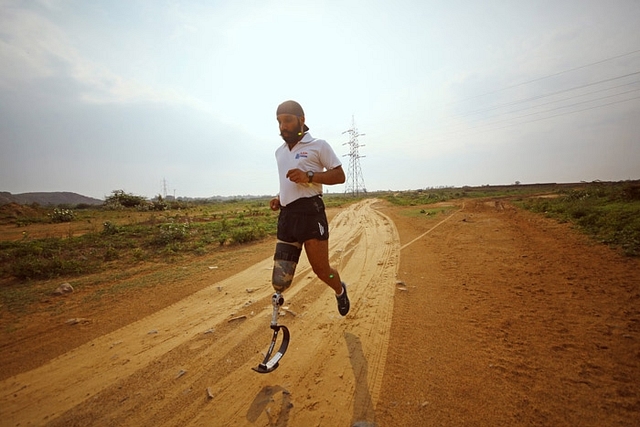
The Indian Blade Runner
In spite of losing his right leg during the Kargil war, Major DP Singh runs marathons with a prosthetic limb, fighting a war against prejudice towards physically challenged persons.
The legend of the Phoenix, the mythical bird’s cyclical regeneration, has fascinated the human civilization. It dies and then is reborn. It rises from the ashes and then soars again.
Maybe, that is why I was fascinated when I met Major DP Singh. In front of me stood a Phoenix in flesh and blood. He had quite literally died and been born again, and now flies higher than he has ever flown before.
The year was 1999. India was at war with Pakistan in Kargil. On July 8th, a mortar from the other side landed in front of a 25-year-old Singh, literally ripping out his internal organs, tearing out tissues and pulverizing his right leg. Covered in blood, he was taken to the field hospital, where the doctor on duty declared him dead.
That is typically the end of most stories of most brave soldiers, who lay down their lives for the nation. But for the young Major, this is where his story would start. While he could not beat “the enemy bullet,” he did manage to beat death. The fighter in him refused to die. At the mortuary, he opened his eyes and was reborn again.
This rebirth came with a price. He had to give up his right limb to save his life. He was amputated.
After spending over a month and a half in the hospital, Singh was transferred to the Armed Forces Medical College’s Artificial Limb Centre (ALC). At that point, this 5-foot 8-inch man weighed barely 30 kgs. To most, he was just a mass of tissue incapable of doing anything on his own.
But Major Singh was gung-ho about being alive. He wanted to go back to his old active self.
“I did not want any mercy or sympathy. I was just thrilled at the thought of being alive again. At that point, I promised myself that come what may, I will not compromise on the quality of my life and will try and continue doing everything that I did before the war.”
Instead of looking at this incident as a setback, he viewed this as a challenge. At the ALC, he was fitted with a prosthetic limb and learned how to walk again.
Released from the army in 2008, Major Singh drifted towards rally car driving. The thought of racing through uncharted terrains excited him. However, the man who defeated death was defeated by an enemy created by us humans – finances.
“Rally racing is an expensive sport, and one needs a lot of funds to keep going. I had no choice but to approach companies for sponsorship. At that time, it hit me that the world looked at my injury as a “disability”. Most companies were just not convinced that, with my situation, I could compete in a brutal sport such as rally driving. They just felt sorry for my situation because, to them, I was not normal.”
At that point, Major Singh realized that, to stop the world from showering him with sympathy, he would have to respond with action.
“The lack of sponsors for my rally racing was a catalyst for me to do something to shut people up. After giving it some thought, I realized that the best way to prove to the world that I was just as capable as an able-bodied man was to do something very fundamental to all humans – run. That was the first time I seriously thought of running.”
After ten years, in 2009, he ran again.
Running for most people is tough. For a man running on a prosthetic limb, it was excruciating. At first, he barely managed 100 meters, falling multiple times but picking himself up each time. Post his runs, he would bleed.
“I did not tell my family before I went for my first run. They only found out after I came back bleeding. My mother bandaged all my wounds. Initially, she would not understand why I was taking on these obstacles. But soon, she realized that this routine was critical for my survival. It was my way of feeling completely alive.”
Today, almost 16 years after his rebirth, Major Singh has completed over 20 marathons and rightfully earned the title of the “Indian Blade Runner”, which is originally associated with the South African sprint runner Oscar Pistorious.
Image: HomeGrown
After beginning to run in 2009, what makes him go on?
“When I was injured, I received blood from countless people across the country. The blood of India is running in my veins. My running is my way of thanking all those who helped me get back and reclaim my life.”
But this Indian superhero is not stopping at running alone. He now runs a successful NGO called The Challenging Ones which has more than 800 amputees.
“We are more than just a support group; my aim is to turn each of these people from physically challenged to a challenger. I meet their families and friends and tell them to please never stop them from doing anything they want.”
He is also on the one rank one pension (OROP) committee.
“A nation needs to always respect their soldiers and not just during wartime. In fact, respect for war widows and veterans is more critical. It is an issue I feel very strongly about. The Indian Army is a great organization and has given me so much. In a way, it made me the person that I am.”
The Indian Army is indeed a phenomenal organization. It has given many heroes to the nation. However, Major Singh’s legend should surpass most of them. Not only did he contribute to help India win a war in the summer of 1999, he now helps India comes closer to winning another war – a war against prejudice.